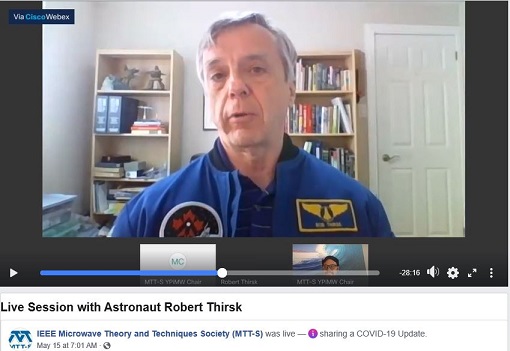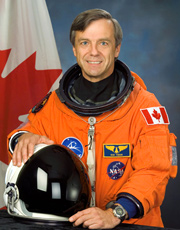Covid-19 Social Distancing:Live Session with Astronaut Robert Thirsk-How to Remain Productive during Pandemic
IEEE MTT-S YP Webinar

MTT-S YP virtual meetings using social networks, organized by Dr. Tushar Sharma.
The online link for live streaming: https://www.facebook.com/IEEEMTT/videos/847884965702491/
Date and Time
Location
Hosts
Registration
-
 Add Event to Calendar
Add Event to Calendar
- Global Access-Facebook Live Video Presenation
- North Jersey, New Jersey
- United States
- Building: Remote-Anywahere
- Contact Event Host
-
Ajay Poddar, email: akpoddar@ieee.org
Mobile: +1(201) 560-3806
- Co-sponsored by IEEE R1 MTT/AP Chapter
Speakers
 Dr. Robert Tirsk
Dr. Robert Tirsk
Covid-19 Social Distancing:Live Session with Astronaut Robert Thirsk
Biography:
Dr. Thirsk attended primary and secondary schools in British Columbia, Alberta, and Manitoba. He received a Bachelor of Science in Mechanical Engineering from the University of Calgary in 1976, a Master of Science in Mechanical Engineering from the Massachusetts Institute of Technology (MIT) in 1978, a Doctorate of Medicine from McGill University in 1982, and a Master of Business Administration from the MIT Sloan School of Management in 1998.
Dr. Thirsk was selected in December 1983 for the Canadian astronaut corps. He began astronaut training in February 1984 and served as backup payload specialist to Marc Garneau for the October 1984 Space Shuttle Mission STS-41G.
He has been involved in various Canadian Space Agency (CSA) projects, including parabolic flight campaigns and mission planning. He served as crew commander for two space mission simulations: the seven-day CAPSULS mission in 1994, at Defence Research and Development Canada in Toronto; and the 11-day NEEMO 7 undersea mission in 2004 at the National Undersea Research Center in Key Largo, Florida. He led an international research team investigating the effect of weightlessness on the heart and blood vessels.
Dr. Thirsk is a strong promoter of a Canadian economy based upon exploration and innovation. He encourages young Canadians to build their dreams upon a solid educational foundation and advanced skills. He works with educational specialists in Canada to develop space-related curriculum for grade school students. Initiatives such as Space for Species, Tomatosphere and From Blue To Red have allowed millions of young Canadians to experience the thrill of scientific discovery. He also holds an adjunct faculty position at the ISU. He co-leads a research team of ISU alumni investigating the effect of space flight on neuroperception.
In 1998, Dr. Thirsk was assigned by the CSA to NASA's Johnson Space Center in Houston to pursue mission specialist training. This training program involved advanced instruction on both Shuttle and International Space Station (ISS) systems, EVA (spacewalking), robotic operations, and Russian language. Within the NASA Astronaut Office, Bob served as a capcom (capsule communicator) for the ISS program.
In 2004, Dr. Thirsk trained at the Yuri Gagarin Cosmonaut Training Centre near Moscow and became certified as a flight engineer for the Soyuz spacecraft. He served as backup flight engineer to European Space Agency (ESA) astronaut Roberto Vittori for the Soyuz 10S taxi mission to the ISS in April 2005. During this 10-day mission, Bob worked as Eurocom (European capcom) at ESA's Columbus Control Centre in Germany. In February 2008, he again performed Eurocom duties from Germany in support of ISS Expedition 16 crew activities.
Space flight experience: In June and July 1996, Dr. Thirsk flew as a payload specialist aboard Space Shuttle Mission STS-78, the Life and Microgravity Spacelab (LMS) mission. During this 17-day flight aboard Columbia, he and his six crewmates performed 43 international experiments devoted to the study of life and materials sciences. The life science experiments investigated changes in plants, animals, and humans under space flight conditions. The materials science experiments examined protein crystallization, fluid physics and high-temperature solidification of multi-phase materials in a weightless environment.
In 2009 Dr. Thirsk became the first Canadian astronaut to go on a long-duration expedition aboard the ISS. He and two crewmates launched from the Baikonur Cosmodrome in Kazakhstan on May 27 aboard a Russian Soyuz spacecraft. When their Soyuz vehicle docked with the nearly complete Station two days later, the ISS became home for the first time to a permanent crew of six. As members of the ISS Expedition 20/21 crew, Dr. Thirsk and his five international crewmates performed an unprecedented amount of multidisciplinary research, complex robotic operations, and maintenance and repair work of Station systems and payloads. Dr. Thirsk lived and worked in space for 188 days during this second voyage to space, which ended when he landed back in Kazakhstan on December 1.
Dr. Thirsk resigned as astronaut and left the CSA in 2012 to join the Canadian Institutes of Health Research in Ottawa. As Vice-President of Public, Government and Institute Affairs, Bob oversaw the 13 institutes dedicated to specific health care issues such as aging and cancer research. In 2014, he retired from the federal government. He served as Chancellor of the University of Calgary from 2014 to 2018. He served as chair of the CSA's Expert Group on the Potential Canadian Healthcare and Biomedical Roles for Deep Space Human Spaceflight in 2017–2018, and currently serves as director on several social purpose organizations.
https://www.asc-csa.gc.ca/eng/astronauts/canadian/former/bio-robert-thirsk.asp
https://www.britannica.com/biography/Robert-Thirsk
Website: www.robertthirsk.ca
Agenda
Virtual Meeting: Participatns can join from anywhere.
The online link for live streaming: https://www.facebook.com/IEEEMTT/videos/847884965702491/

